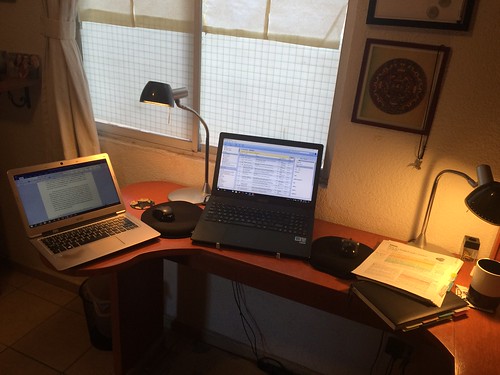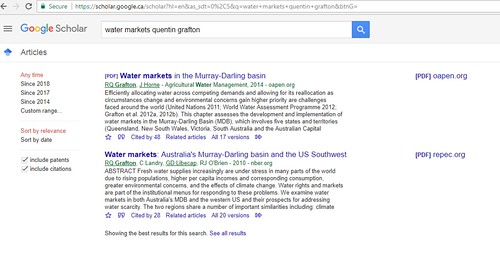One of the first questions I get asked on Twitter (I’m at @raulpacheco) is: “how do I get started on X?” It’s always hard because to be perfectly honest, a lot of things I don’t even realize how I got started, I just know that I now know how to do them. And because I actually do know how to do them, I share openly with the world. Mapping new fields of scholarship is something nobody taught me how to do, but I’ve developed a strategy throughout the years that works for me, and it may work for you too.
The process I use to map a new field of scholarship looks something like this:
- Decide on the topic of interest.
- Ask trusted advisors for suggestions of key citations and/or authors.
- Run a citation tracing process on the above-mentioned cites and authors.
- Run a Google Search for top-cited papers in the field.
- From Steps 3 and 4, create a mind map of key authors and topics.
- Choose 3-7 articles for the topic, and 3-5 for each sub-topic.
- Read (or if under extreme time pressure, apply AIC Content Extraction and Conceptual Synthesis Excel Dump method) to create a visual and analytical map of the field.
- Expand the mind-map as necessary and continue searching and reading/annotating/highlighting/scribbling until I reach conceptual saturation.
Now, let’s go through step by step:
1. Decide on the topic of interest.
Here, I knew I wanted to do a paper on informal water vending.
2. Ask trusted advisors for suggestions of key citations and/or authors.
Try Debbie cheng, katherine furlong, Michelle kooy, Katie Meehan 🙂
— Nikhil Anand (@liquidperson) January 18, 2018
@raulpacheco I am sure you have seen the special issue of Water Alternatives on the theme of informality in the water sector?! https://t.co/AWnbhGfBsS
— Margreet Zwarteveen (@mzwarteveen) January 24, 2018
3. Run a citation tracing process on the above-mentioned cites and authors.
I already knew that Quentin Grafton had done work on the Murray-Darling basin and on formalized water markets, so I searched for him and did a citation tracing process.
4. Run a Google Search for top-cited papers in the field.
For example, on the topic of informality in water provision, if we use a simplistic divide (formal and informal, which @maliniranga 2018 demonstrates is not as simple, and it's actually a continuum, but let's assume binary divide) then I need key citations on formal water markets pic.twitter.com/ak38JFoDOo
— Dr Raul Pacheco-Vega (@raulpacheco) January 27, 2018
I would also add that you can run a Google Scholar Search on the authors you KNOW work in the field too.
One reason why I really try to read broadly is that even if I have never worked in a field, I know a few key authors from previous readings. I had already read @dustingarrick 's book on water markets in the Murray-Darling basin, so I Google Searched for his works on formal ones. pic.twitter.com/t82pPx5fLM
— Dr Raul Pacheco-Vega (@raulpacheco) January 27, 2018
I never worked on formal tradable water rights, but @dustingarrick has, so his papers will be of help for me as I map out the formal and informal water markets field. Now, on to informal markets. GS search yields @Michelle_Kooy and @maliniranga @Farhana_H2O pic.twitter.com/JCHeneTsfO
— Dr Raul Pacheco-Vega (@raulpacheco) January 27, 2018
5. From Steps 3 and 4, create a mind map of key authors and topics.
This is where asking authors, or meeting them at conferences helps. I know several of the authors I have mentioned very well, including Michelle Kooy (who like me did her PhD at UBC), Malini Ranganathan, etc.
So now I have @paulahanasz @micheleleemoore @GraftonQuentin @dustingarrick 's contributions all mapped in a mind map of water markets pic.twitter.com/aIxrHyXj3F
— Dr Raul Pacheco-Vega (@raulpacheco) January 27, 2018
6. Choose 3-7 articles for the topic, and 3-5 for each sub-topic
Here, I knew I needed to read Michelle Kooy, Amber Wutich, Andrea Marston (I’ve already read them, but again, let’s assume I haven’t – my mind-map and Conceptual Synthesis Excel Dump both show I would need to read them in order to get a grasp on the field of water and informality)
Then I would use @geographiti (Andrea Marston) and @AWutich on Bolivia (Cochabamba). That's 3 rows in the Excel dump. Then @maliniranga
— Dr Raul Pacheco-Vega (@raulpacheco) January 25, 2018
7. Read (or if under extreme time pressure, apply AIC Content Extraction and Conceptual Synthesis Excel Dump method) to create a visual and analytical map of the field.
This is a snapshot of my Conceptual Synthesis Excel Dump for water informality – as you can see, I have mapped out case studies, theoretical overviews, etc. This exercise allows me to gain insight into who has written about the topic, covering which cases, what lessons learned. pic.twitter.com/uRM14AZOVi
— Dr Raul Pacheco-Vega (@raulpacheco) January 26, 2018
So, let's imagine I haven't read these works… if I only have time for ONE paper, I can read one a day, and within two weeks, I can more or less get a broad overview of who has studied water informality, and which cases they have examined, roughly. There will still be gaps.
— Dr Raul Pacheco-Vega (@raulpacheco) January 26, 2018
8. Expand the mind-map as necessary and continue searching and reading/annotating/highlighting/scribbling until reaching conceptual saturation.
While I have a good mind-map of what the field of water informality and the continuum/spectrum/divide of formal and informal water markets looks like, I still need to read more to reach conceptual saturation. So, I go back to Step 1 in this process until I’ve found the right number of citations (I’ve written on this topic before, i.e. when to stop reading and how to decide when you have got enough sources and you’ve read enough).
My entire set of posts on Literature Reviews can be found here if you need to search for a specific technique I’ve mentioned in this blog post.



0 Responses
Stay in touch with the conversation, subscribe to the RSS feed for comments on this post.